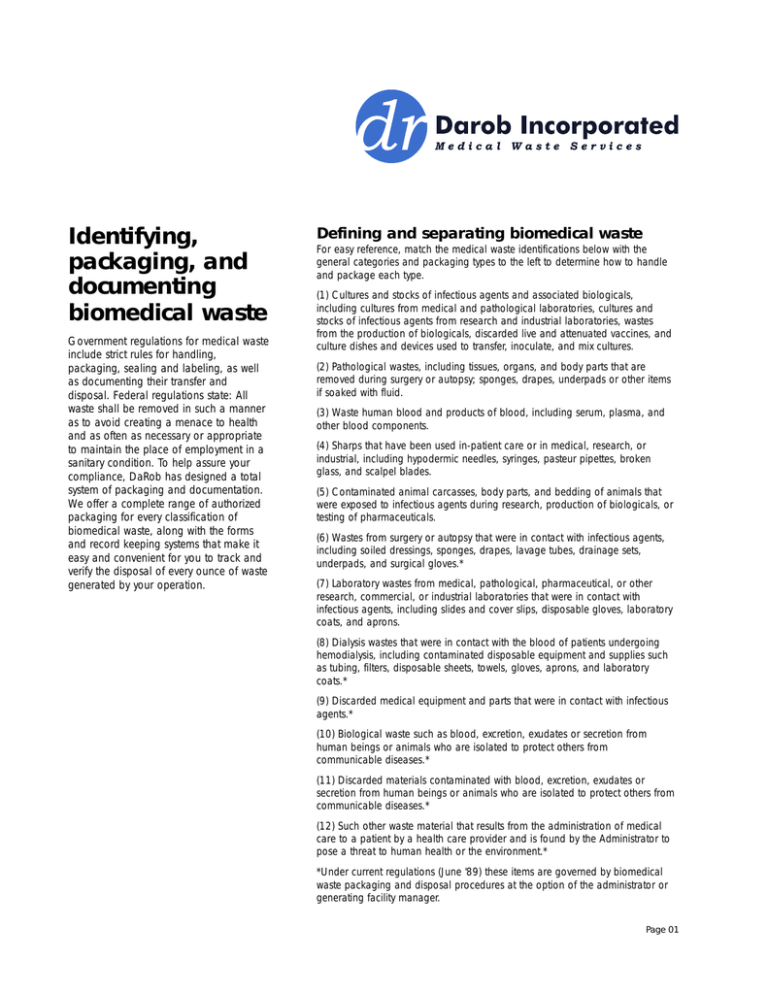Identifying, packaging, and documenting biomedical waste
advertisement

Identifying, packaging, and documenting biomedical waste Government regulations for medical waste include strict rules for handling, packaging, sealing and labeling, as well as documenting their transfer and disposal. Federal regulations state: All waste shall be removed in such a manner as to avoid creating a menace to health and as often as necessary or appropriate to maintain the place of employment in a sanitary condition. To help assure your compliance, DaRob has designed a total system of packaging and documentation. We offer a complete range of authorized packaging for every classification of biomedical waste, along with the forms and record keeping systems that make it easy and convenient for you to track and verify the disposal of every ounce of waste generated by your operation. Defining and separating biomedical waste For easy reference, match the medical waste identifications below with the general categories and packaging types to the left to determine how to handle and package each type. (1) Cultures and stocks of infectious agents and associated biologicals, including cultures from medical and pathological laboratories, cultures and stocks of infectious agents from research and industrial laboratories, wastes from the production of biologicals, discarded live and attenuated vaccines, and culture dishes and devices used to transfer, inoculate, and mix cultures. (2) Pathological wastes, including tissues, organs, and body parts that are removed during surgery or autopsy; sponges, drapes, underpads or other items if soaked with fluid. (3) Waste human blood and products of blood, including serum, plasma, and other blood components. (4) Sharps that have been used in-patient care or in medical, research, or industrial, including hypodermic needles, syringes, pasteur pipettes, broken glass, and scalpel blades. (5) Contaminated animal carcasses, body parts, and bedding of animals that were exposed to infectious agents during research, production of biologicals, or testing of pharmaceuticals. (6) Wastes from surgery or autopsy that were in contact with infectious agents, including soiled dressings, sponges, drapes, lavage tubes, drainage sets, underpads, and surgical gloves.* (7) Laboratory wastes from medical, pathological, pharmaceutical, or other research, commercial, or industrial laboratories that were in contact with infectious agents, including slides and cover slips, disposable gloves, laboratory coats, and aprons. (8) Dialysis wastes that were in contact with the blood of patients undergoing hemodialysis, including contaminated disposable equipment and supplies such as tubing, filters, disposable sheets, towels, gloves, aprons, and laboratory coats.* (9) Discarded medical equipment and parts that were in contact with infectious agents.* (10) Biological waste such as blood, excretion, exudates or secretion from human beings or animals who are isolated to protect others from communicable diseases.* (11) Discarded materials contaminated with blood, excretion, exudates or secretion from human beings or animals who are isolated to protect others from communicable diseases.* (12) Such other waste material that results from the administration of medical care to a patient by a health care provider and is found by the Administrator to pose a threat to human health or the environment.* *Under current regulations (June '89) these items are governed by biomedical waste packaging and disposal procedures at the option of the administrator or generating facility manager. Page 01 Packaging Category B Solid & Pathological Waste Container 1 x 2 x Documenting biomedical waste disposal L Liquid Waste (greater than 20 cc) Container x 3 x 4 5 x 6 x 7 x x 8 9 x x 10 11 S Sharps Container x 12 Descriptions of interior and exterior containers >> Interior container B (red bags) is a red plastic bag, with a mil strength adequate for an inner liner, with a capacity to fit the outer container. >> Interior container L (rigid liquid) is a rigid clear plastic container, with sealable cap for liquid, available in varied sizes. >> Interior container S (rigid sharps) is a rigid plastic container for sharps and needles, available in several sizes. >> Exterior container A is red plastic reusable box or drum, in 30-gallon and 40-gallon capacity. Packaging procedures All biomedical wastes must be double packaged at a minimum. After filling appropriate inner containers/liners, seal them securely by tying or taping the red bags shut. Then if not currently in a shipping container, place carefully into the exterior shipping container, and seal it securely with the top or lid specified for that container. Different categories of inner packages may be placed in the same exterior package as long as no chemotherapy waste is present. Containers should be placed as close as possible to where biomedical wastes are generated so there is minimal handling of unpackaged waste. The Medical Waste Tracking Form System Use the four part tracking forms from DaRob, Inc., fill in all required information on the left of the form as "generator", the facility that generates biomedical waste. DaRob is the destination facility and, if you are utilizing DaRob's transportation services, we are also the transporter: As such, we will complete the information on the right hand side of the form. The USDOT has included Regulated Medical Waste in the Hazardous Materials Tracking Act. This regulation affects all generators of medical waste with additional tracking requirements, training specifications, and further packaging requirements. Contact us for the updated materials you may need. Record Keeping Establish a file system using the DaRob file folder. Each time you prepare containers for shipment and create a tracking form, file Part 4 for your records. Once your shipment has been received by DaRob and your biomedical waste has been treated, DaRob will return Part I for your files verifying the fact that your materials have been received and destroyed. This provides you complete protection, under the law and assurance that your biomedical wastes have been properly handled in complete compliance. For more information, please contact us. Darob, Incorporated P.O. Box 99085 1801 Research Drive Louisville, KY 40269 T 502-491-1535 or 1-877-MDWASTE F 502-491-2264 W www.darobinc.com Page 02

